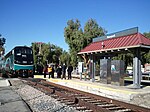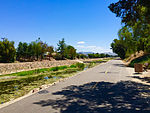Moorpark station

Moorpark station is a passenger rail station in the city of Moorpark, California. Service commenced in 1983 as an infill station on the short-lived CalTrain line. The station was rebuilt in 1992 to accommodate the new Metrolink Ventura County Line commuter trains. Service on that line began on October 26, 1992; Amtrak's Santa Barbara–San Diego San Diegan trains had begun stopping there the day before.Amtrak's Pacific Surfliner from San Luis Obispo to San Diego and Metrolink's Ventura County Line from Los Angeles Union Station to East Ventura stop here. Moorpark station is served by ten Amtrak Pacific Surfliner trains (five in each direction) every day, with departures evenly spaced throughout the day. Sixteen Metrolink Ventura County Line trains (eight in each direction) serve the station each weekday, running during peak hours in the peak direction of travel. On weekends, four Metrolink Ventura County Line trains (two in each direction) serve the station. Metrolink passengers also have access to all Pacific Surfliner trains through a codesharing arrangement with Amtrak.Moorpark served as the Ventura County Line's terminal until service was extended to Oxnard after the Northridge earthquake in 1994, and now acts as the western terminus of the Ventura County Line except during peak hours in the peak direction of travel. Metrolink stores trains in a small yard a short distance west of the station.In FY2018, boarding or detraining Amtrak passengers averaged approximately 50 passengers daily.
Excerpt from the Wikipedia article Moorpark station (License: CC BY-SA 3.0, Authors, Images).Moorpark station
East High Street,
Geographical coordinates (GPS) Address Nearby Places Show on map
Geographical coordinates (GPS)
| Latitude | Longitude |
|---|---|
| N 34.285277777778 ° | E -118.87694444444 ° |
Address
Old Town Business District
East High Street
93021
California, United States
Open on Google Maps



